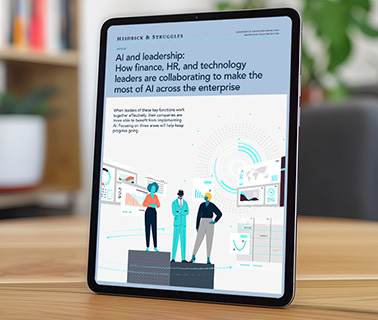Key insights: Heidrick & Struggles CPO Summit
1. Uncertainty and volatility are real—but not new
Secretary Condoleezza Rice reminded leaders that while the world feels turbulent today, uncertainty is not unprecedented. She compared today’s environment to the late 1940s, a time marked by U.S.–Soviet tension, the birth of the nuclear age, doubts about the future of democracy, and the reconstruction of the global economy. Her message: the best leaders succeed not by predicting the future, but by anchoring teams in clarity during ambiguity. That requires disciplined scenario planning, connecting the past to the future through compelling narrative, grounding decisions in facts rather than vibes, and resisting the temptation to overreact to every crisis. She acknowledged that change is disorienting, and that the first step in navigating through it is to admit and accept that and then figure out how to move forward. Secretary Rice also shared a way to help determine the appropriate level of reaction to times of volatility: calm confidence wins, so leaders’ first task is understanding if the problem we are facing is a) are we out of paperclips or b) is this the risk of nuclear war? She added that the best leaders need to lead with humility and curiosity. These leadership traits are timeless—and essential in the age of AI and constant disruption.
2. The CPO’s role is expanding—and so is CPO compensation
The importance of talent and culture as strategic differentiators is increasing, not diminishing. Leadership, and leadership planning, are becoming ever more material to performance, particularly as companies invest heavily in AI and technology. Business performance now hinges on identifying the uniquely human work—judgment, empathy, innovation, connection—that separates good organizations from great ones. This shift has solidified the role of the CPO as a true enterprise leader, forming a new power axis with the CEO and CFO. Compensation trends reflect this growing influence: total compensation for CPOs has grown faster than for most other C-suite roles over the past two decades: In 1993, less than 3% of CPOs were among the highest paid executives at their company, now that number is 14%. The modern CPO is not merely a talent operator—they are a chief architect of enterprise transformation.
3. Decide who benefits from AI to accelerate benefits
AI will unlock productivity, innovation, and cost efficiencies—but before those gains appear in financial results, organizations must answer a fundamental question: who benefits from AI-driven value creation? As Laszlo Bock posed the question: will AI gains go entirely to margin expansion and shareholders, or will employees share in the upside through compensation, capability-building, or redesigned roles? The CPO must partner early with the CFO to not only shape, but also advocate for, a strategy of value distribution that is net beneficial to all stakeholders. If employees see AI as something done with them rather than to them—and know they will share in the benefits—they will accelerate experimentation and adoption rather than resist it.
4. A responsible AI strategy is about where to experiment—but also when and with whom
Boards and CEOs are pushing for AI adoption at speed, and HR leaders are enabling experimentation by training managers to identify use cases and lowering emotional barriers to trying new tools. But speed alone is not a strategy. The economics of AI are still changing rapidly: token costs continue to fall but ROI is uneven as early adopters learn expensive lessons. Meanwhile, AI capabilities remain scarce inside organizations, driving leading CPOs to partner with external technology specialists rather than trying to build end-to-end capabilities from scratch. The smartest leaders are experimenting aggressively and learning today, but cautiously making major investments as the economics stabilize and the vendor landscape becomes clearer. In AI, the winners will not necessarily be the first movers, but the first to scale wisely.
5. AI will change work—and the structure of organizations—in ways we don’t expect
Most headlines focus on AI disrupting entry-level work, and hiring data supports that shift, with some estimates showing reductions in campus hiring of up to 13% in jobs most exposed to AI. But this is only the beginning. For years, companies used global labor arbitrage to move work to lower-cost regions. That model is now under pressure as AI becomes cheaper than offshoring for many tasks. But HR executives need to be aware that 4 to 7 years from now the ripple effect of replacing entry-level workers with AI will start to manifest as companies will start to face a shortage of capable front-line managers.
Beyond labor cost strategies, AI will also reshape how organizations are designed. Current AI tools mostly improve individual productivity—writing code faster, drafting content, summarizing emails—but have not yet transformed organizational productivity, which depends on collaboration, decision flow, and cross-functional work. Once AI begins to accelerate team-based work, we will see the real productivity unlock. AI solutions that reimagine how employees work together will do more than replace some types of work—it will enable employees to create new products, services and solutions that are not yet envisioned.
6. Succession management isn’t optional—it drives measurable performance
A recent study of 150,000 proxy statements across almost 19,000 companies showed that firms investing in structured succession management outperform those that don’t—not just in leadership continuity but in financial results, including stock market returns. The trend line is clear: more organizations are building disciplined succession pipelines, and those that do gain resilience, continuity, and long-term value. Succession planning has evolved from a risk mitigation activity into a competitive advantage.
7. The hybrid work debate is effectively over—manage performance, not presence
Despite ongoing headlines about return-to-office mandates, the market has reached a post-pandemic equilibrium. Based on data collected by Nicholas Bloom, employees now work from home 25% of the time. In addition, while there is industry-level variability, the dominant work paradigm, adopted by 69% of employers, is structured flexibility—not fully remote and not fully in-office—but creating predictability about which days employees are in the office. This approach achieves the best talent outcomes with slightly higher performance, and 35% lower employee quit rates compared to employees who are fully in-office. The real shift now is not about where work happens, but how performance is managed. To reap the benefits of the new operating model, measurable outcomes should be rewarded over physical presence.


